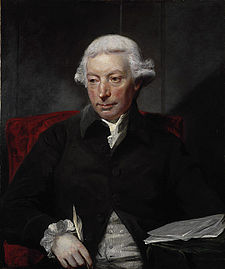Fashion & Beauty:
Adam Smith and Celebrity Fashion
Is vanity objectively disordered? Is our age of fashion an indifferent individualism, as Francis contends? Scheler and Francis are both Tories but the former thinks the primary problem is a stifling collectivism. How pervasive is the spiritual vampire? The cult of celebrity suggests we are vampiric but are all celebrity sightings equal? Is there no significant moral difference between a Kardashian fashion spread and a photograph of Kate Middleton? Doesn’t a fashion photo of the Duchess of Cambridge make us intimates of the values of beauty and goodness?

Alain de Botton observes there is something that rings false about the eighteenth-century claim that work and happiness go together.[1] Hume’s celebratory tone rings less true than the cautions one finds, oddly enough, in Adam Smith. Yet as Smith points out, our skepticism that commercial civilisation delivers happiness is off set by its leading edge, the spell of our fantasies and fascination with beautiful people and their “equipage” (TMS, 50-51).[2] Does this fascination root a worthy solidarity? Whether vanity and fashion subvert or aid moral order depends, ultimately, on whether morality is isolated from the aesthetic.[3] In the seventh chapter, I discuss the ethics of Aurel Kolnai. He attempts a modern rehabilitation of nobility: with the patience of a classical phenomenologist, he discerns the value tones of nobility and the connection the value has with refinement. Interestingly, Kolnai shares this view with Adam Ferguson, a Scottish contemporary of Smith’s, and his one-time friend.[4] Their proposal: Whig and Tory can be reconciled. I do not think Smith precisely shows the path to this reconciliation but he does provide the platform by drawing together morality and beauty.

Adam Ferguson
2
At the heart of Adam Smith’s ethics is his Platonism, a conviction that the imagination is governed by beauty (TMS, 11, 35-37, 117). For Smith, moral approbation is understood in terms of what is becoming and well-formed and moral disapprobation in terms of the unseemly and ill-formed. It is very important to appreciate that for Smith utility is not basic (TMS, 12) to commercial life, but secondary to the pursuit of beauty (TMS, 179-80). Though it is commonly thought that people work for leisure — think of the oft-heard ambition to retire when 40 — Smith thinks that the origin of ambition in leisure is more apparent than real. Underwriting our ideas of work and leisure is the desire to complete a system of beauty (TMS, 182-83). Smith’s portrait of the ambitious young man (TMS, 181) — and just how evocative it is for today’s students will readily be seen by anyone who teaches it — describes a youth whose life is given over to work in service of a leisure that forever escapes him: that is because leisure is not the real object of pursuit but rather is the completion of a beautiful arrangement, a harmony and flow of objects.[5] This confusion befalls all in commercial civilisation and is a matter of “enchantment,” a spell cast by glamour (TMS, 181). Celebrity fashion is not, thinks Smith, vampiric, but one instance of the human fascination with complex arrangements, or, to use Hume’s phrase, the refinement of the arts and sciences:
3
If we examine, however, why the spectator distinguishes with such admiration the condition of the rich and the great, we shall find that it is not so much upon account of their superior ease or pleasure which they are supposed to enjoy, as of the numberless artificial and elegant contrivances for promoting this ease or pleasure… And it is the ingenious and artful adjustment of those means to the end for which they were intended, that is the principal source of his admiration (TMS, 182).
4
It is because of the complex flow of beautiful things that people wish to live close to palaces and avoid living near prisons. The utility of the prison is obvious but it is inelegant: palaces are largely useless, or worse, yet because they are becoming they attract (TMS, 35). A palace:
…will always be agreeable… [even though] it may serve to promote luxury, and set the example of the dissolution of manners. [However] the conveniency, the pleasure, and the gaiety of the people who live in it, being all agreeable, and suggesting to the imagination a thousand agreeable ideas, that faculty generally rests upon them (TMS, 35).
5
Consider the supermarket: Why at the cash register are there magazines of celebrities, beautiful cars, elaborately prepared foods, homes and gardens, design and fashion spreads? Why are there no magazines about academics or the latest innovations in coal mining? Why are there hundreds of blogs devoted to celebrity sightings and their escapades, their fashion successes and failures, as well as the hundreds of Tumblr and Instagram pages street blogging fashion? Smith has told us the answer: certain objects carry in their train a “thousand agreeable ideas.”[6] This chapter is less interested in Smith’s claim that fashion properly describes the clothes worn by those of “high rank, or character” (TMS, 194-95) but more in his claim that celebrity and fashion prompt sympathy, moral approbation.

6
Sympathy is given to those objects, events, and persons keyed to a “thousand agreeable ideas,” as Smith puts it. We relate to others almost in the medium of fantasy. It is for this reason that people dress carefully for work or dates,[7] why people on gaming and role-play sites invariably make themselves more attractive, dynamic, characterful,[8] and why collecting certain objects is understandable (classic cars) but not others (Nazi memorabilia).[9] Smith’s insight is also applied in developing the faces and manners of robots,[10] as well as in the design of mannequins used to display clothes in shops.[11]
7
Consider the hair extensions market. The Hindu temple in the ancient city of Tirupati in India is a site of pilgrimage for young women wishing to gift the gods with their hair.[12] From infancy their hair has been tended with an eye to making it a gift to the gods. Once their heads are shaved, the monks collect the hair and start it on the long road to cities like Los Angeles where hair from the temple is highly valued by customers wanting hair extensions. Prices can top $250 for the hair. The monks use the money they earn from sale of the hair — and they go through 50,000 razor blades a day — to maintain the temple, feed pilgrims, and help the poor of the city.
The young women do not know about this trade in their gift to the gods. Is this moral?

8
Smith’s ethics is built around vanity but vanity requires a spectator. Basic to Smith’s theory is the role of the spectator. A person is moral if a spectator can role-play her situation and exhibit the same sentiments she discloses. This harmony of sentiment is sympathy, and this is what it means to be judged ethical, for Smith. Unsurprisingly, Smith dwells on the spectator: he explores what a spectator is, how many spectators there are, whether they agree, and how to resolve conflicts amongst them.
The temple hair trade is a case of two spectators. The Western spectator, the people in LA who marvel at the lustre of a woman’s hair out in the city, gives sympathy: the woman stands out, she is affirmed, a cloud of agreeable ideas surrounds the richness and bounce of her hair. The Indian spectator is also pleased. The women with the shaved heads are seen as pious, they have made an astonishing gift: they have taken a great adornment off themselves and bestowed it upon the gods. In the eyes of both spectators the trade in hair is good. You might think there is a third spectator, the Western spectator alert to the inner workings of the trade: aware that the young Indian women do not know about what happens to their hair; a spectator discomforted knowing that the young women gain nothing financially from the trade. However, Smith points out that the spectator looks at the surface of a phenomenon and seldom goes probing (TMS, 35). Whether in India or the West, few bother to probe beneath the piety or the glamour.
9
Were the spectator to go inquiring matters might not be obvious. Pope Francis has reaffirmed a long-standing principle of Catholic social thought: the universal destination of goods. This norm calls for the participation of all in economic goods through the exercise of work. On the one hand, these women are not economic participants in the trade even though the care of their hair for years in advance is work: the norm would call for them to be paid. On the other hand, worship of the gods always includes gifts. We saw in the previous chapter that Benedict XVI argues that all economic transactions depend on gift.
10
Smith is clear that the ease with which we grant the glamorous our sympathy is a source of moral precariousness. That merit earns a grudging esteem whereas beauty gains rapid recognition is, he says, a source of moral corruption (TMS, 56, 61-62). Far from tying esteem to merit, the imagination divides persons into those of “rank and distinction” and those of “spirit and ambition.” The latter must exhibit “probity and prudence, generosity and frankness” and a man of ambition must work patiently to “acquire superior knowledge of his profession, and superior industry in the exercise of it” (TMS, 55). By contrast, the man of rank has few talents but much grace and “to figure at a ball is his great triumph,” as Smith rather marvelously says. However, if opportunity presents, the man of talent and ambition will strive to take advantage of events that “may draw upon himself the attention and admiration of mankind” (TMS, 55). This ambition, thinks Smith, is the seed of fraud and immoral business practice (TMS, 64-65). Moral life is precarious because ambition is basic:
… what are the advantages which we propose by that great purpose of human life which we call bettering our condition? To be observed, to be attended to, to be taken notice of with sympathy, complacency, and approbation, are all the advantages which we can propose to derive from it. It is the vanity, not the ease, or the pleasure, which interests us (TMS, 50).
11
Ambition folds into vanity. The man of rank — the celebrity — gains sympathy by the elegance of his deportment and the refinement of objects with which he adorns himself; in this case, merit matters not at all, merely beauty. As Smith puts it:
“These are the arts by which he proposes to make mankind more easily submit to his authority, and to govern their inclinations according to his own pleasure: and in this he is seldom disappointed” (TMS, 54; emphasis added).
12
What to think of the curious case of Jay-Z and Cristal Champagne?[13] In 2006 the heir of the Roederer Champagne house, Frederic Rouzaud, took over as managing director. In an interview, Rouzaud regretted that Jay-Z was so attached to Cristal and kept figuring it in his music videos. Jay-Z took umbrage and in subsequent videos has a waiter bring him champagne only to dismiss it when it is Cristal. Indeed, subsequently, Jay Z invested (controversially) in a different champagne house.[14]

13
Adam Smith would be puzzled by Rouzaud’s decision and the WSJ certainly was. They marveled that anyone would cast off the free publicity a star of Jay-Z’s magnitude brings. The WSJ did note that brand pollution is a genuine problem. They cite the case of Burberry which, favoured by English football fans, became associated with their laddish behavior. However, they also noted that the football fans sported knock-offs and not the expensive “real deal,” whereas Jay-Z was encouraging people to buy actual Cristal.
14


From a Smithian perspective, the puzzle is that Jay-Z is a celebrity and the spectator loves celebrities. If Cristal is unimpressed by Jay-Z, who figures well at a ball, perhaps Smith’s theory is wrong? Smith would point out that this is again a case of two spectators. One, in sympathy with those who wish to better their condition: the other, rather dismayed that someone might think her condition could be improved upon. Jay-Z makes no bones about the fact that he is the consummate “man of ambition,” a “thruster” always looking for the main chance. One can well imagine Cristal’s traditional customer, long established in the upper reaches of society, looking askance at pop videos like “On to the Next One” and “Let Me Upgrade U.” Of course, since to be moral is to be at one with the spectator, Cristal could favour either families with pedigree or Jay-Z’s up-and-comers and still have an adoring spectator. It is an enviable position for a luxury business to be in. Roederer is over two hundred years old and uses horse-drawn ploughs lest the vigour of tractors rattle the vines: it is hardly surprising that Rouzaud favoured the brand’s old, aristocratic clients, who likely voiced that they did not much like been confused with les arrivistes.
15
Despite Scheler’s horror of the spiritual vampire there is a remarkable continuity between Smith and Scheler in their mutual appreciation for axiology. Axiology is the idea that besides natural facts there are moral facts and, in the language of the European school,[15] these moral facts are phenomenological tones — discrete, self-contained, value essences e.g. the taste of a peach or malice. It is twinned with intuitionism: the idea that the mind has a direct grasp of moral facts.[16] Thomas Reid, who replaced Adam Smith as Chair of Moral Philosophy at Glasgow, offers some nicely turned examples. Speaking of revenge, he says: the “state of a mind enflamed by resentment and meditating upon revenge: It is surely of all states the most undesirable, the most unlovely” (PE, 168). He writes:
So universal a consent of mankind with regard to the main points of right and wrong of virtue and vice ought to satisfy the most skeptical not only of the reality of the distinction between the one and the other, but also that the Almighty has taken care of the constitution of our nature, to make this distinction so apparent and obvious that it requires no deep enquiry or laborious reasoning to discover it (PE, 179; emphasis added).[17]
16
In a vivid description of a murder, Smith voices the same point:
To the man who first saw an inhuman murder, committed from avarice, envy, or unjust resentment, and upon one too that loved and trusted the murderer, who beheld the last agonies of the dying person, who heard him, with his expiring breath, complain more of the perfidy and ingratitude of his false friend, than of the violence that had been done to him, there could be no occasion, in order to conceive how horrible such an action was, that he should reflect… His detestation of this crime, it is evident, would arise instantaneously and antecedent to his having formed to himself any such general rule (TMS, 159).
Reid puts this point more formally:
… an immediate perception of right and wrong, of moral rectitude and depravity, in moral agents, in like manner as we have a perception of black and white in visible objects by the eyes, of harmony and discord by a musical ear, and of other qualities in objects, by means of the several faculties of our nature, which are adapted so by the author of our nature as to give us not only the ideas of such qualities but an immediate perception of their existence in certain subjects (PE, 144).
17
Axiology discerns the value order underlying this intuitive grasp of the moral character of events, acts, and persons. In Smith’s account an aesthetic order is shot through nature, the effects of which strike the imagination, itself sensitive and deferential, to this order. Put differently, the spectator is a basically sound reflection of the aesthetic-moral order. Smith develops this value structure as a formatted contrast, arguing that what makes for the agreeable is: utility or fitness; “certain colours… give more delight to the eye the first time it ever beholds them;” a smooth surface; variety; and coherence. These positive values contrast with objects and acts: that exhibit weak utility; less pleasing hues; rough surfaces; “a tedious undiversified uniformity;” and “a disjointed and disorderly assemblage of unconnected objects” (TMS, 199-200). Luxury follows this axiology, as does the palace, and the celebrity. Smith has some amusing comments about watches and they certainly follow the axiology. There is an interesting video of pop star John Mayer talking about his collection of watches. He speaks about watches as objects of ambition, but also of history, and lovingly dwells on their compositional qualities.
18
Scheler’s value hierarchy complements Smith’s axiology nicely. Values of the holy and person top the hierarchy followed by intellectual and cultural, vital bodily, and lastly, practical, values. To these values correspond social forms of religious practice and personal formation, the cultivation of the sciences and arts, the role of the family and land, and, finally, economic institutions and myriad mechanisms for business interaction and daily living. Scheler’s hierarchy explains why an Aston Martin and a Toyota Prius are both cars, they have pragmatic value in moving people from A to B. However, an object is judged better, the more it realizes the hierarchy. The Aston Martin is all horsepower and agility (vital values) whereas the Prius is on the turgid end of things. The British marque is a design object of fluidity and grace, the Prius ungainly. The Aston Martin is hardly venerated but it is admired: people stop to look and appreciate it, and more, likely think the person driving it is somewhat interesting. It is no surprise that James Bond drives an Aston Martin.
19
Scheler and Smith largely agree on the logic of valuation. Though Scheler believed Smith had badly misstated the character of sympathy it is clear that luxury objects fare well on his value hierarchy. Moral failure stems from a prioritization of beautiful objects over persons. Benedict — no stranger to style — helps us understand how “feel good fashion” can link fashion and the just treatment of persons. But I think it is Scheler who offers us the optimum model in his idea of the estate.
20
FOOTNOTES
[1] A. de Botton, The Pleasures and Sorrows of Work (New York: Pantheon Books, 2009), pp. 106-09.
[2] Though the skills levels of the workers in haute couture are incredible, ways are historically low. For the savoir-faire of les petits mains, as the workers are called, see http://www.telegraph.co.uk/luxury/womens-style/46256/the-making-of-a-dolce-gabbana-alta-moda-masterpiece.html. Fashion theorist and historian, Elizabeth Wilson explains the low wages thus: “the theatrical world fascinated many of the workers” (Adorned in Dreams, p. 89). The truth of this comment is fully on display in the documentary film, Dior and I.
[3] “In China, Nothing Says ‘I Love You’ Like Matching Smiley-Face Shirts” (Laurie Burkitt).
[4] Smith and Ferguson seem to have had a falling out over precisely which of them really thought through the full implications of the division of labour.
[5] This insight is vividly on display in Cartier’s short film, L’Odyssee de Cartier and cunningly in the shopping experience of perfumes at Labo.
[6] “Does Your Work Wife Get a Valentine?” (Sue Shellenbarger).
[7] “Overexposed: Surviving the Corporate Outing” (Christina Binkley).
[8] “Is This Man Cheating on His Wife?” (Alexandra Alter).
[9] “Good Business or Bad Taste?” (Erica E. Phillips).
[10] “How to Make Robots Seem Less Creepy” (Adam Waytz).
[11] “Don’t Call Them Dummies” (Ray A. Smith).
[12] “The Locks Market” (Allure Magazine. March 2009. Katherine Zoepf).
[13] “Jay-Z to Roederer Champagne: Drop Dead” (Eric Felten).
[14] Ace of Spades is Jay-Z’s brand. Each bottle costs less than 14$ to make yet the mark up is horrendous, retailing at over 200$. Add to this that knowledgeable people think the drink awful. Amongst various articles on the topic, see Zack O’Malley, “The Symbolism in Jay-Z’s Choice of Champagne,” The Atlantic Monthly, 2014.
[15] M. Scheler, Formalism in Ethics and Non-Formal Ethics of Values (Evanston, IL: Northwestern University Press, 1973), pp. 13-14, 68, 196-97.
[16] There is a good variety of theoretical positions that all claim to be intuitionist but for the basics see the summary in Jesse Prinz, The Emotional Construction of Morals (Oxford: Oxford University Press, 2009), pp. 87-88.
[17] T. Reid, Practical Ethics, ed. K. Haakonssen (Princeton: Princeton University Press, 1990): henceforth = PE.